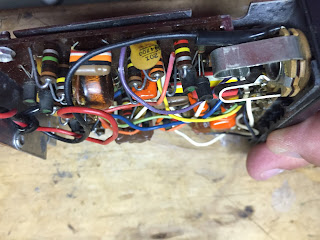The octave divider, which was part of the Vox guitar amplifier line manufactured by the Thomas organ company, allowed a trumpet player to lower the pitch of his/her instrument by one or two octaves. It was called the Octavoice, and you can read more about it here:
http://www.voxshowroom.com/us/amp/octavoice.html
To use the Octavoice, the trumpet player drilled a hole in the mouthpiece, and screwed in an adapter that allowed the Octavoice's transducer fitting to be attached to the mouthpiece. Since I'm a trombonist, this picture shows the fitting on a trombone mouthpiece.
And when the transducer is attached to the mouthpiece, it looks like this.
This device was produced in the late 1960s or early 1970s, so there is no digital signal processing going on. Inside the box are a bunch of transistors, resistors, capacitors, and inductors - not even any IC op amds. I'm a little stymied on how this box could produce an octave shift down, but I am a computer engineer, not an electrical engineer. Here are some photos of the inside of the box.
Whether or not I understand how it works, it does work. I used it to record the "tuba" track for an entry in the contest to be the song on the flexi-disc included with the Billy And The Boingers Bootleg collection of Bloom County comics by Berkeley Breathed. We didn't win, since we weren't so heavy metal, but I still do sort of like the song we made.
So, for DBaylies: if anyone can offer suggestions on how to build something similar to how build a mouthpiece-attached transducer, post here. The goal is to get an audio signal into the input of an analog-digital converter for processing in the digital domain.





Cool! My my does that circuitry look messy though. But it works!
ReplyDeleteMy project is coming along - the Teensy works well, although the 1024 point FFT doesn't allow for great frequency resolution in the lower register. I'm currently looking into improving this resolution, as well as exploring other methods of transduction altogether.
Hope you're well!
hi there, octave down effects in analog domain are never done with fft or the like, and are therefore very fast. if you understand how it is done in analog, you can code a very fast version too.
ReplyDeletebasically the signal gets squared and then run through a flip-flop (an arrangement of two transistors that activates either one or the other when an input goes high) nowadays there are flip-flop ic's. if you just "read" one of the flip flops output, you get....yes, half the frequency of the input, or octave down. so you take this squarewave and lowpass it again heavily to make it sound not so synthie and distorted. if you want to get fancy you read the envelope of the input and reapply it to the octave down signal. and if you want to get really fancy, you should stitch the original audio together based on the ovtave down squarewave. that is what is done in the oc-2 octaver by boss (all analog). here is a good link of a diy project that uses a similar approach to get very smooth octave down tones: http://www.valvewizard.co.uk/uboat.html
cheers
Lokki, thanks for explaining how the analog octave-splitting works!
Deletehope it helps... based on your breath controller entries i ordered an mpxv4006 to use with my ribbon midi bass controller (http://synthstuff.blogspot.ch), let's see how that goes. so thank you for this blog!
ReplyDeleteI know this is ancient, but just to throw it out there Barcus-Barry used to make a piezo pickup from Brass instruments, and there's a guy in Australia who will sell you something similar (https://piezobarrel.com/landing.htm). You had to drill a hole in your mouthpiece to install it. I used to use on my trumpet and play through a Roland Space Chorus and a guitar amp. Our sound man was not impressed, we would always fight over whether to mic the trumpet or my amp. Eventually I gave up and bought a clip-on mic.
ReplyDeleteGreat post! I appreciate the clear and insightful way you've presented this topic. Your thoughtful approach makes complex ideas easy to understand and very practical. I’ve learned some valuable tips that I can use, and I look forward to reading more of your content. Keep up the fantastic work!
ReplyDeletePressure Sensor ICs
Enrgtech